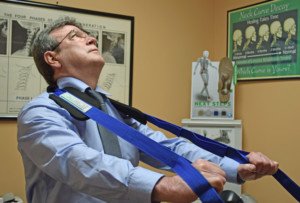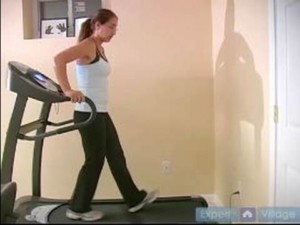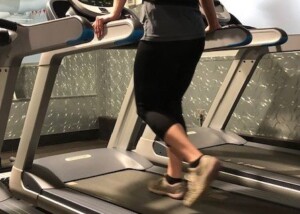Find out why you should not hold onto a treadmill while walking backwards…
Nearly every time when I see someone walking backwards on a treadmill, that individual is holding onto the side rails.
When I was a personal trainer at a large gym and saw this, I’d tell him or her that this was wrong and that it defeated the purpose — whatever that person’s goal was.
“Walking backwards hands free improves posture,” says Dr. Tom Carpenter, corrective exercise specialist, certified personal trainer and chiropractor, inventor of Stand Corrected™, a portable harness-like stretching tool that helps alleviate back, neck and shoulder pain.
“It does this by engaging the posture muscles to a much higher level than normal,” continues Dr. Carpenter. “It strengthens the quads and calves as well as the stabilizing muscles for the hips, knees and ankles.
“Your body is forced to balance itself to a greater degree than normal by walking in a completely different way than it is accustomed to.
“Even though it may feel a little awkward at first, letting go of the support and allowing your body to learn to move more naturally when walking backwards will increase coordination, balance and stability.”
I’m a former certified personal trainer with a large gym, and I’m going to explain why even a light grip defeats the purpose of walking backwards and has other disadvantages.
Your first reaction might be, “But holding on is smart because it prevents falling off.”
However, if the speed is slow enough, you won’t fall off. I’ve had many clients walking backwards on a treadmill and I’d start them off at 1 mph.
The problem is that people typically try to walk backwards at much faster speeds.
Though I’ll also point out that sometimes I’ll see someone holding on while walking backwards at a very slow speed.
Regardless of speed, holding onto a treadmill while walking backwards will defeat the purpose of this different approach to movement.
So why do you walk backwards on a treadmill?
You have a reason or two.
- Is it because you read somewhere it helps alleviate knee pain?
- Or perhaps you read that “muscle confusion” will burn more calories.
- Maybe you’re bored moving forwards?
Reason aside, you should teach yourself NOT to hold on, because the whole point of walking backwards is to — walk backwards in the true sense of the word, to keep up with a moving tread in the opposite direction.
If you hold onto the rails, the rails become stabilization points, relieving your body’s stabilizer muscles (which include those in the core) from their duties. What good is this?
Furthermore, holding onto the rails encourages bad posture. Next time you see someone holding on while walking backwards, note their posture: shoulders, neck, spine, the whole works. The entire gait is wrong.
Now, if you do not hold on while walking backwards on a treadmill, you will be forced into executing perfect posture! I mean perfect!
Stabilizer muscles will be fully engaged to prevent you from falling, and major muscles will be doing all the work.
Start the Right Way
Start out at 1 mph and walk backwards without holding onto the treadmill. Watch your feet if you must.
Or watch the edge of the tread belt, or even the floor just beyond it; you’ll find your sweet spot.
As you get used to moving hands-free, increase the speed a little.
When your legs must keep up with a tread that’s moving backwards, without your hands assisting on the rails, this will force your legs to become more efficient; it will force your ankle, knee and hip joints to become stronger in a unique way.
To reap benefits from walking backwards on a treadmill, go for five to 10 minutes, and swing the arms naturally in synch with your body rather than hold onto the rails.

Photo credit: Aleesia Forni










































